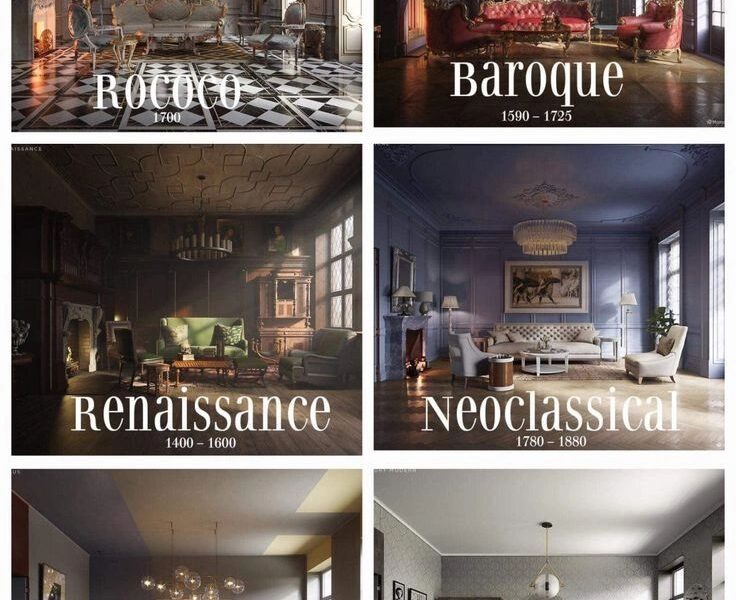The right flooring should match your desired look and durability needs, without costing you an arm and a leg.
Wood Flooring
Best for: Entire home, except for wet environments
Wood flooring has remained a top flooring material throughout history for many reasons. It’s durable, can last several lifetimes, and is unmatched in authentic beauty. After all, it’s the real thing, not a replica.
Oak is the most commonly used hardwood flooring species, but other species like cherry and maple are popular options. Every hardwood species can be further customized through patterned layouts and finish options.
When choosing hardwood floors one of the most important things to consider is where in your home you’ll be installing them.
If you’re installing your floors in your home and ABOVE grade or ground level, you can use solid hardwood flooring. If you’re installing your new floor in the basement or BELOW grade, you’ll need to use engineered hardwood as it is more resistant to moisture. Engineered hardwood is also the best choice for installing in condos.
If your subfloor is concrete, engineered hardwood is your best choice. If you have a wooden subfloor, stick with solid hardwood.
Solid Hardwood vs. Engineered Hardwood
| Features | Solid Hardwood | Engineered Hardwood |
|---|---|---|
| Material | 100% solid hardwood throughout | Thin hardwood veneer bonded to a plywood core |
| Lifespan | 50+ years | 20-30 years |
| Installation Method | Nail down | Nail down, floating, or glue-down |
| Dimensional Stability* | May warp in humid, damp conditions | Good resistance to moisture due to plywood core |
| Sanding/Refinishing | Can be sanded many times, including deep sanding | One or two light sandings or until a veneer thickness of 3/32-inch |
| Cost | Typically more expensive upfront | Generally more affordable than solid hardwood |
| Dimensionally stable | 35%-55% | 35%-60% |
| Suitable for basements (below grade) | Not Suitable | ✓ |
| Can be sanded and refinished | ✓ | ✓ |
| Durable and long-lasting | ✓ | ✓ |
| Available in a variety of wood species | ✓ | ✓ |
| Radiant heat approved | Not Suitable | ✓ **refer to manufacturers install guide |
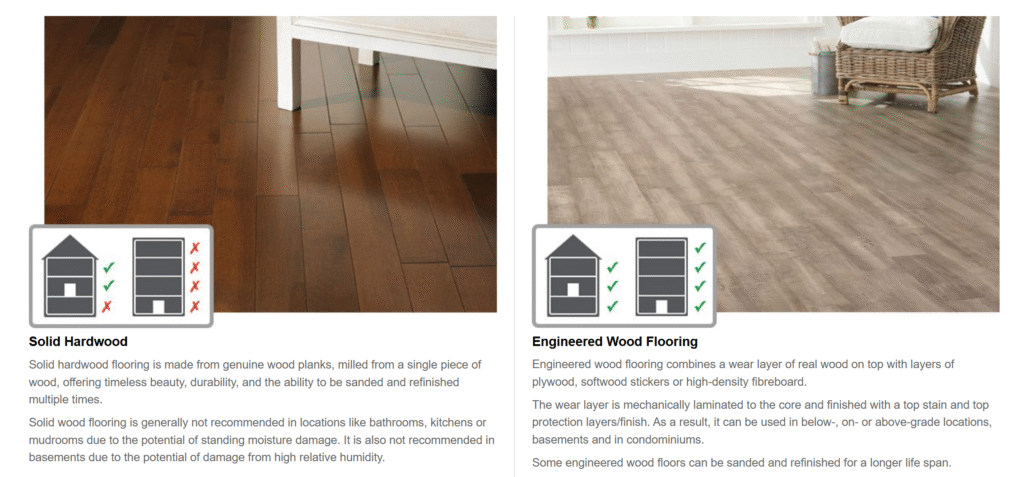
Pros
- Beautiful appearance
- Durable
- Can be refinished
Cons
- Sensitive to moisture
- Expensive
- Can scratch easily
Hybrid Resilient Flooring
Hybrid resilient flooring is a pretty new type of flooring that combines the best features of vinyl and laminate flooring types. Hybrid flooring has a rigid core that makes it waterproof and durable, and it has a top layer that can mimic the look of wood, tile, or stone. It’s a breeze to install and maintain, so it’s a hit with both homeowners and renters.
It is known for its durability, being scratch resistant, waterproof, and pet proof, while also capturing the aesthetic of wood-look flooring. This innovative flooring is typically composed of multiple blended materials, including plastic and limestone, making it a versatile choice for various spaces.
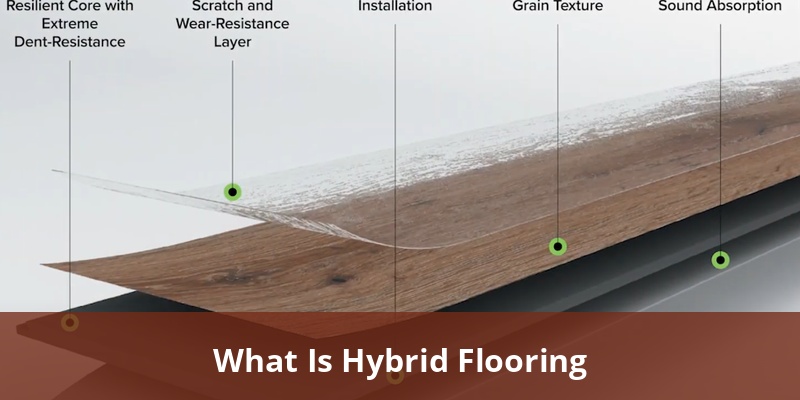
The first generation of hybrid flooring was SPC (Stone Plastic Composite), which combines limestone (80%) and PVC (20%) in its core. While initially marketed as a “miracle product,” SPC had its challenges. It required a perfectly level subfloor due to its rigid nature and used a basic 2G click system, which locked boards laterally but not vertically. Furthermore, SPC contained silica, a potentially hazardous binding agent associated with the disease silicosis.
To address these shortcomings, the second generation of hybrid flooring, WPC (Wood Plastic Composite), replaced limestone with wood powder in its core. While this improved flexibility, wood powder was not 100% waterproof, limiting its performance.
The third generation and modern “Next Generation Hybrid Flooring” replaced these cores with a virgin aerated polymer core. This innovation improved flexibility, made the flooring 100% waterproof, enhanced acoustic properties, and introduced a premium 5G locking mechanism. The 5G click system locks boards securely both laterally and vertically and makes installation simple and efficient.
Today, hybrid flooring combines a commercially rated luxury vinyl plank top layer with a durable polymer core and a pre-attached EVA foam underlay for added comfort and noise reduction.
Pros:
- Exceptional Water Resistance
- Durability For Busy Households
- Comfortable Underfoot
- Versatile Style Options
- Low Maintenance And Cleaning
Cons:
- Potential For Temperature Limitations
- Less Authentic Wood Feel
- Click-Lock Systems And Installation Precision
- Price Differences Among Brands
Vinyl Flooring
Best for: Bathrooms, kitchens, basements, whole home
Vinyl flooring is inexpensive and highly durable, making it a great flooring option for those with kids and pets. Best of all, vinyl flooring is easy to install, saving you the cost of professional installation. A downside is that vinyl flooring requires a perfectly level, smooth, and flat subfloor. Other types of flooring can bridge minor imperfections, but vinyl flooring cannot.
Like laminate, luxury vinyl flooring provides the look of wood, but with an array of other benefits as well. There are a number of options to choose from when it comes to vinyl floors including grout-able vinyl tiles, vinyl planks and vinyl sheets.
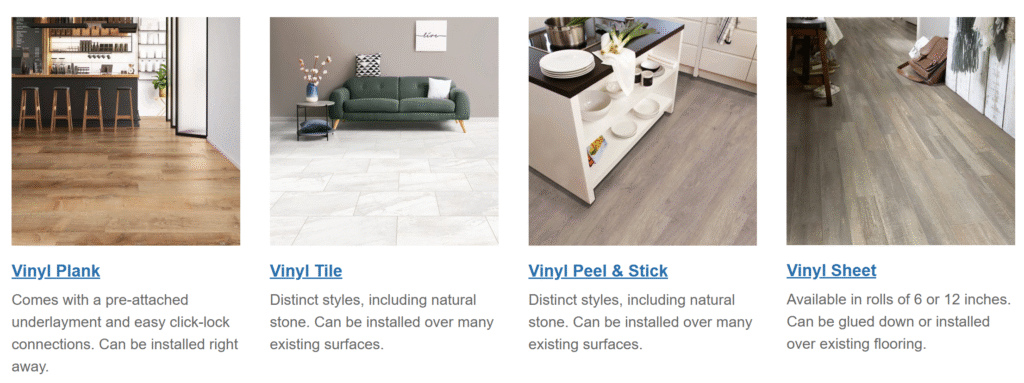
Modern vinyl plank flooring and vinyl floor tiles come in many different designs, which mean an assortment of installation methods. Peel and stick vinyl flooring and click vinyl flooring are among the easiest for homeowners to install. Other options include sheet vinyl flooring, glue down vinyl flooring, loose lay vinyl flooring and floating vinyl flooring. These are best handled by professional installers or homeowners with more advanced flooring knowledge.
Pros:
- Water-resistant or waterproof
- Affordable
- DIY-friendly install
Cons:
- Cannot be refinished
- Not eco-friendly
- Subfloor must be perfect
Laminate Flooring
Best for: Bathrooms, kitchens, basements, whole home
Laminate flooring is perfect if you want the look of hardwood flooring without the high price point. Though most laminate looks like wood, it can also reliably mimic the look of stone and tile.
Laminate flooring is available in a wide variety of styles and colors, mimicking natural wood and stone finishes. You can find options like hand-scraped, rustic, reclaimed wood, and more. Some advanced laminate floors feature waterproof technology, making them easy to clean and maintain. Additionally, there are scratch-proof laminate flooring options available, ensuring durability for your home. While there is no such thing as a truly waterproof laminate flooring, most laminate is water-resistant.
Laminate flooring is comprised of four layers, a backing layer, fibreboard core, decorative layer and a tread or wear layer. The layers are combined to form one extremely dense surface. This handy infographic will explain the different layers in depth.
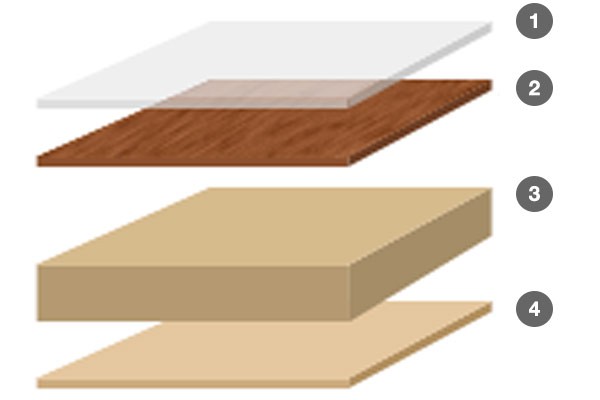
1. The Wear Layer – coats and seals the Decorative layer. This top layer gives the floor its resistance to scratching, UV rays, burning ash and embers and chemical agents. Most decors have a melamine resin-based coating containing Aluminum Oxide. Some decors have a multi-step lacquer finish.
2. The Decorative Layer – gives the laminate floor the beauty an elegance of an actual hardwood or tile floor. It is a high-definition photographic print (paper or direct to HDF) of a particular wood species.
3. The Core Layer – is made of High Density Fibreboard (HDF), giving the laminate durability and high impact resistance. This allows the floor to withstand the shock of localized impacts such as high-heeled shoes and dropped objects.
4. The Backing Layer – is the base layer that gives the laminate additional stability while making the laminate a floating floor.
The Abrasion Criteria (AC) rating identifies suitable uses for laminate on a scale from 1 to 5 – the higher the number, the more durable. For residential use, look for laminate with an AC rating of 3 or 4.
1: Very light foot traffic; suitable for bedrooms
2: Moderate foot traffic; suitable for living rooms
3: Heavy residential traffic; suitable for all areas
4: Residential or commercial traffic
5: Heavy commercial traffic
Pros
- Affordable
- Durable
- Wide range of styles
Cons
- Sensitive to moisture
- Cannot be refinished
- May delaminate
Other floorings
Before selecting the right flooring for your area, consider the daily traffic patterns and the way in which the space is used.
Bamboo Flooring: Bamboo flooring is a low-maintenance, durable alternative to hardwood flooring.
Cork Flooring: Cork flooring isn’t as popular as traditional materials like hardwood or tile but its many unique qualities make it a flooring material worth getting to know. Cork is naturally pest-resistant, offers a soft underfoot feeling, and even has insulative qualities that dampen sounds.
Tile Flooring: Tile flooring is a long-established favourite because of its durability and resistance to moisture. Tile comes in ceramic, porcelain, glass, metal, and natural stone varieties, offering a wide array of looks from which to choose. Some materials are best suited for wall tile projects like bathroom walls and kitchen backsplashes, while others like ceramic and porcelain tiles are great options for bathroom floor tiles and kitchen tiles.
Linoleum Flooring: Linoleum is highly regarded for its durability and budget-friendliness. Often mistaken for sheet vinyl, linoleum is available in sheets and tiles with a nearly endless list of styles.

